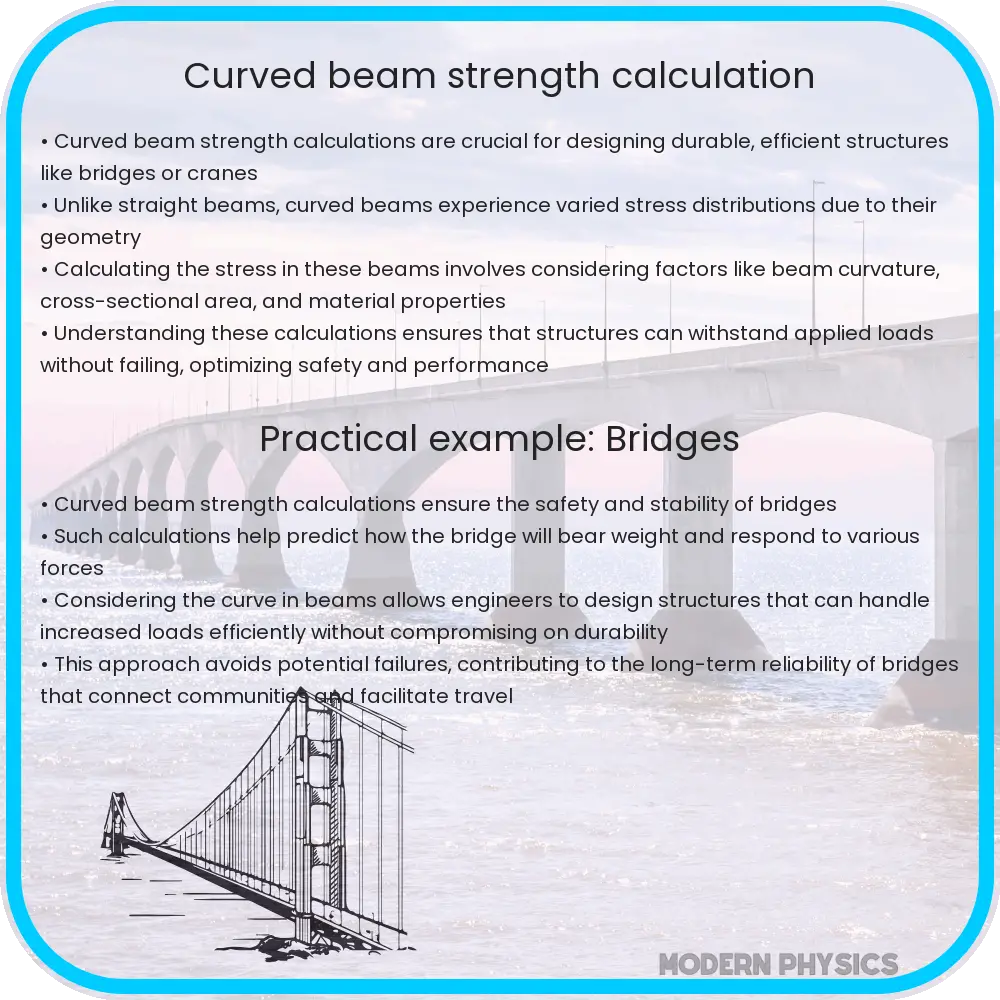Explore curved beam strength, stress analysis, design strategies, and applications in engineering with advanced calculation methods.

Understanding Curved Beam Strength: Fundamental Concepts
Curved beams, unlike straight beams, navigate an additional layer of complexity in their structural behavior and strength calculations. These beams, commonly found in arches, bridges, and various mechanical parts, exhibit unique stress distribution due to their curvature. This article delves into the core principles of curved beam strength, addressing stress analysis, design considerations, and theoretical underpinnings.
Stress Analysis in Curved Beams
The primary distinction in stress analysis of curved beams lies in the non-uniform distribution of stress across the section. Unlike straight beams under bending where stress varies linearly from tension to compression, curved beams experience a more complex distribution due to the curvature effect. The stress at any point in a curved beam can be represented as:
σ = (M*y)/[I + (e2 – y2)*A]
Where σ is the bending stress, M is the moment, y is the distance from the neutral axis, I is the moment of inertia, e is the distance from the center of curvature to the neutral axis, and A is the cross-sectional area.
Curved Beam Design Considerations
Designing curved beams involves more than just ensuring they can withstand applied loads. Factors like material selection, cross-sectional shape, and the radius of curvature play crucial roles. A smaller radius of curvature intensifies stress concentrations, necessitating careful consideration of material properties such as elasticity and tensile strength. Additionally, the cross-sectional shape influences how well the beam can resist bending and torsional stresses.
Theoretical Background
The theory of curved beams extends from Bernoulli’s beam theory, integrating the curvature’s influence into the stress-strain relationship. It recognizes that, in curved beams, the neutral axis does not coincide with the centroidal axis, altering the standard bending stress formula. This necessitates a modified approach to analyze and design these beams effectively.
Understanding these fundamentals paves the way for deeper exploration into specific design strategies, calculation methodologies, and application examples of curved beams, which will be covered in the following section of this article.
Advanced Design Strategies and Calculation Methodologies
Delving further into curved beam design, advanced strategies involve optimizing the beam’s geometry and material for specific applications. For instance, in bridge construction, the arch shape is often tweaked to balance aesthetics with structural integrity. Additionally, the use of high-strength materials can compensate for stress concentrations due to curvature.
Calculation methodologies for curved beams often employ numerical methods, such as finite element analysis (FEA), which provide a more accurate representation of stress distribution than traditional analytical methods. FEA allows engineers to model complex geometries and material behaviors under various loading conditions, offering a comprehensive understanding of the beam’s performance.
Application Examples of Curved Beams
Curved beams find applications in numerous fields. In architecture, they are prominent in arches and domes, providing both aesthetic appeal and structural support. In mechanical engineering, curved beams are integral to components like crane hooks and frames of vehicles where the curvature imparts additional strength or flexibility.
In aerospace, curved beams are used in fuselage structures and wing design, where their shape aids in withstanding aerodynamic loads while minimizing weight. In civil engineering, curved beams are essential in bridge design, where they not only support structural loads but also enhance the bridge’s aesthetic value.
Conclusion
The study and application of curved beam strength encompass a wide range of disciplines, from architectural design to aerospace engineering. Understanding the unique stress distribution in curved beams is crucial for safe and efficient design. With the advent of sophisticated computational tools like finite element analysis, engineers can now predict the behavior of curved beams under various conditions with greater accuracy.
Curved beams not only serve a structural purpose but also add aesthetic value to designs, exemplifying the intersection of art and engineering. As materials and computational methods continue to evolve, the possibilities for innovative uses of curved beams in various industries are bound to expand, pushing the boundaries of modern engineering and design.
